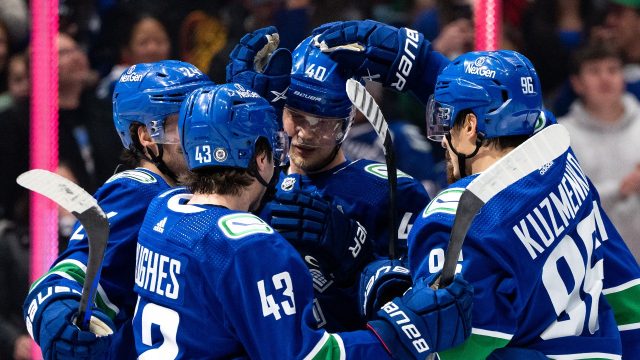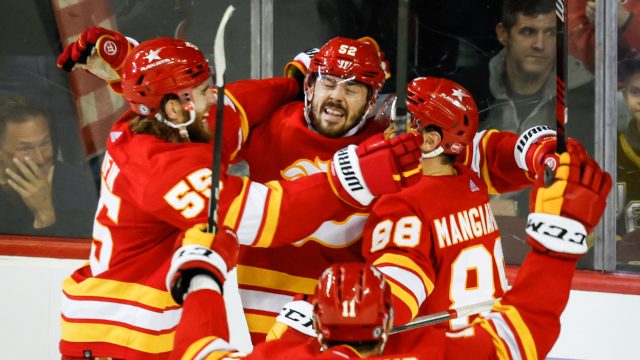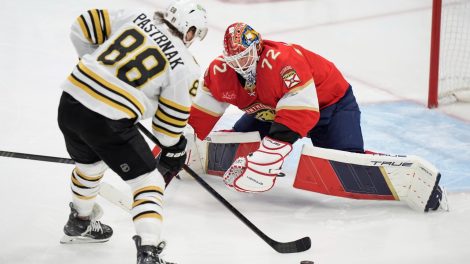If you ever pop by the NHL’s new “EDGE” data page, it doesn’t take long to confirm something you already knew: turns out these NHL guys can skate at a pretty good clip. At the top of the list of “max speed reached” you’ll see the name Brayden Point, who at one point this season got cooking at nearly 40 kilometres per hour.
Really think about that: 40 km/h. We lose context of the speed amidst a sea of great skaters, but the next time you’re buzzing along in your vehicle going somewhere around that number, imagine him skating alongside the car. He’d get a massive ticket in a school zone.
More precisely, his top speed was 24.15 miles per hour, which equals 38.9 km/h. And it’s not like the moment he hit that speed was some anomaly for the league, as the other players in the top 10 are all within one km/hr of his speed.
I was discussing this with Brant Berglund, the NHL’s Sr. Director of Coaching and GM Applications, when he pointed out a few interesting tidbits regarding speed in the NHL that led us here. Below is a look at where and how speed really shows up in the NHL, jumping entirely off the back of Brant’s work and ideas, with a little of my own seasoning.
One-hand long, two-hands strong
The bolded line above is a coaching staple that’s meant to inform younger hockey players about when to have one hand on their stick, and when two. Essentially, any time you’re opening up the throttle and getting into those long, powerful strides, you want to have one hand on your stick – you just can’t skate as fast with two hands on the stick. Two hands are for traffic, for any time the opponent is around, for puck battles, and for shooting.
As you, dear reader, may have already assumed, the NHL’s top speeds are by-and-large achieved by players who have gone “long,” with one hand on their stick.
Wind it up
A drag car can’t hit peak speed down a bowling alley. They need some length to get up to speed, and they generally need a little bit of space. As you’ll see below, the majority of the clips show players who’ve had time to wind it up from one end, dig into a few hard crossovers, then get jumping into a straight-line sprint.
All Game States
What I enjoy most about the clips below is that you can see players turn to max speed in just about every game state – with the puck and without, on offence and defence. The two that stand out are a bit later in the pack, with Brandon Tanev ripping back to cover defensively, and Mackenzie Weegar desperately working back against the Vegas Golden Knights.
The guy who looks the outright fastest in all these clips, to me, is Miles Wood of the Avalanche, who’s racing to negate an icing against players that barely realize they’re in a race, given Wood started from so far back.
Let’s have a look, then do a bit more analysis.
TOP 10 MAX SPEEDS
Some summary notes from Brant, on the “one hand long, two hands strong” thing:
Five of the top 10 fastest players were on the offensive team
Of those five, just one had the puck while having two hands on their stick, and that only happened when it came time to make a play. Another two had the puck but just one hand on the stick as they raced up-ice, and two had two hands on their stick (with no puck) as they were driving the net and in traffic.
In sum, the offensive guys were one-handed until they were in traffic.
Three players were in neutral possession game states
All three had just one hand on their stick; two raced to chase down icings and the third a dump-in.
Two players were on defence
Both of them had one hand on their stick until they caught the action and it became time to make a play.
The conclusion from Brant and I is one pretty much all coaches have reached: any time you’re trying to create max speed (either for separation or for closing distance), it’s one-hand time. When you’re playing in the traffic, it’s time to get that bottom hand on the stick.
NO CONNOR MCDAVID?
I also recognize a question that has been on your mind here: “Wait, Connor McDavid isn’t on the list?”
And it’s true, no, he isn’t on that list. His top speed so far this season would be…11th, or exactly .01 mp/h behind Roope Hintz for 10th among forwards, who show up most frequently based on their roles. But to get a sense for just how fast McDavid plays, you have to look at the speed burst category, where he has the second-most bursts of 22-plus mp/h (a crazy-high cutoff), second to only Nathan MacKinnon, who’s an absolute bull of a hockey player and constantly moving his feet.
MacKinnon probably doesn’t get the “fastest guy in the game” love in the same way that McDavid does, but as you saw, his top speed this year was second-best in the NHL.
Here’s the top-10 list for speed bursts:
PLAYER | 22+ MP/H SPEED BURSTS |
Nathan MacKinnon | 54 |
Connor McDavid | 32 |
Brayden Point | 28 |
Roope Hintz | 27 |
Martin Necas | 26 |
Owen Tippett | 23 |
Miles Wood | 21 |
Kasperi Kapanen | 17 |
Ryan McLeod | 17 |
Yegor Chinakov | 15 |
If you drop the speed burst cut-off to 20 miles per hour, look how often MacKinnon, McDavid – and yes, Mr. Point – are putting the opposing team on its heels. This list to me is your true collection of “fastest skaters in the league.”
PLAYER | 20+ MP/H SPEED BURSTS |
Nathan MacKinnon | 363 |
Brayden Point | 254 |
Connor McDavid | 219 |
Roope Hintz | 202 |
Martin Necas | 197 |
Ryan McLeod | 181 |
Josh Anderson | 179 |
Mathew Barzal | 166 |
Adam Fantilli | 156 |
Jack Eichel | 146 |
The NHL’s Edge site is a great place to dig into player speed and draw conclusions about their games. This is particularly true when you compare a player’s speed bursts to their previous years of play (more on that coming).
For now, it’s just fun to take a moment to watch in awe at the situations where players make a huge hockey rink look tiny by covering the length of it in seconds.
We’re less than a month away from the NHL All-Star Game, where we’ll see players compete in the fastest skater event, one of the marquee attractions. As noted above, you’ll see every guy in that event skate with one hand on their stick, and yes, McDavid is still one of the favourites. But looking at the lists above, it’s clear he’ll have plenty of competition around the league.









